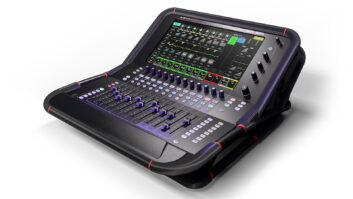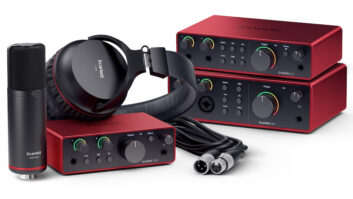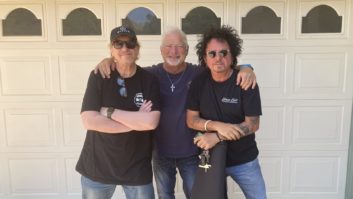Bear Rinehart has appropriated his young sons’ names, Wilder and Woods, for his first solo venture away from his group, NEEDTOBREATHE. Wilder Woods was a handy guise for Rinehart when the initial songs from his debut, self-titled album first emerged, a way to get listeners to focus on the music rather than the musician, particularly as NEEDTOBREATHE is still in full swing as Wilder Woods is set for release.
With six NEEDTOBREATHE albums in almost two decades, Rinehart knows his way around a studio. Each of the NEEDTOBREATHE band members, however, has their area of specialty, and Rinehart’s is not the nuts-and-bolts part of the process.
“I had to start by myself and I didn’t know how to start,” says Rinehart. “I didn’t think of myself as someone who could do a demo. I spent four or five months not just on writing songs, but also on my Logic skills, overcoming that hurdle.
“I used a guitar and piano to write, which is similar to the band, but it was the first time I was writing songs without a drummer in the room. That was a challenge, but also freeing. I got into sampling and splicing beats, just experimenting, like you do when you’re starting out. It’s been a long time since I’ve been in that spot.”
Once Rinehart had the angle of the album musically and lyrically, he took his demos to Nashville, where there is a wealth of musicians, far more than his hometown of Charleston, S.C. He connected with producer and songwriter Gabe Simon, who until Wilder Woods had never produced an entire album. Simon, one-time member of Kopecky, has had a hand in songs for Dua Lipa and Gin Wigmore, but he had no knowledge of NEEDTOBREATHE, which was the best place he could come from for Rinehart.
“I didn’t realize I wanted this, but I really liked working with producers and musicians that were on the alternative and pop side,” says Rinehart. “I come from such a rock ‘n’ roll background, the way that meshed was really good. The people I enjoyed the most scared me the most, in the sense that they would take a left turn when I was thinking right.”
This disparity in musical backgrounds is the driving creative force at the core of Wilder Woods. Rinehart’s voice is allowed to explore previously uncharted territory. He exudes sweetness and tenderness on “Mary, You’re Wrong,” and deep into the bowels of lo-fi soul on “Sure Ain’t”—one of the standouts on the album—and stripped-back Americana on the gravelly “Someday Soon.”
Rinehart set up camp at Layman Drug Company Studios for Wilder Woods with the distinct honor of being the first ever album recorded in that space. The openness of the room, the hard surfaces and vinyl flooring ,plus dimmable lighting, all lent themselves to both the spirit and the sound Rinehart and Simon were trying to capture.
“We wanted the drums to have a room sound to them that was a ‘50s doo-wop, Phil Spector kind of openness,” says Rinehart. “In my experience, room for drums is really important because a drummer tends to play busier in a dry room. If you play too many toms, it starts to get muddy. If the room is really open, it feels like the beats get straighter, and that forces your drummer into a nice music place.”
Additionally, the live room is in full view of the control room, which is an essential characteristic for Rinehart, who was going for a haunting 1950s/’60s feeling for the vocals, which he sometimes tracks from the control room watching the musicians in the live room, and sometimes in the live room.
Says Simon, “Having Jesse Baylin and The Watson Twins doing background vocals in the room separated by baffles and singing into these beautiful mics, conducting them and orchestrating how they’re singing, how they’re swaying, how they’re enunciating and doing their consonants, I felt like I was making a record in 1968 or 1973.”
The backing vocals are recorded while everyone is singing at the same time into separate microphones in order to have bleed capture the warmth. For Rinehart, at times he was recorded in stereo with two Audio-Technica 4033 microphones, such as on “Someday Soon,” in order to create an intimacy that comes from hearing him sometimes more on the left or more on the right. For songs like “Light Shine In” and “Mary,” he is recorded in the control room on a Shure SM7B.
“We went through the Tree Audio console,” says Konrad Snyder who engineered Wilder Woods. “Most of the harmonic distortion heard on the album is straight off the console. We wanted to keep the natural signal, so we didn’t do a lot of parallel compression. But [Rinehart] likes to sing to compression, so out of the Tree console we went into a splitter. One channel went into an 1176 that we panned because we like really aggressive sounds. One channel went into a Retro Sta-Level. One channel went into a Distressor. And we would also run it through the Bricasti reverb in real time; and we swapped pedals on every song.”
Part of the reason for this approach is Rinehart’s dynamic range, which when it is on the soft side, is difficult to hear. For this, Snyder mixes the compressor signal in order to be able to hear the articulation in Rinehart’s voice. Says Snyder, “[Rinehart] and [Simon] run on momentum. What gives them momentum is being excited by the product. You have to be emotionally connected to a take. It should sound mixed for them, and for them to not hear that, they’re not going to give the best they can give.”
Similar to the vocals, when the drum sounds are captured, they are done so with a pure signal, but what’s heard is a lot of parallel compression for a super slammed signal in order to generate the energy during recording.
“It wasn’t necessarily a sonic choice,” says Snyder of recording the musicians, sometimes together, sometimes not. “It was more the emotional energy of the performance that is flowing between them that changes the dynamic, giving them more to feed off of in order to manipulate their performance into what [Rinehart] and [Simon] have envisioned.”
The musicians on Wilder Woods—most notably, Tyler Burkum, Jeremy Lutino, Ian Fitchuk, and Darren King—are all producers in their own right, which Rinehart feels was a key factor in keeping the song-forward attitude on the album. Their stellar performances are bolstered and turned on their heads with unexpected twists such as adding Roland 808s to the drums and treating guitars as samples, cutting them up and reversing them.
“It’s two polar opposite people coming together,” says Simon of himself and Rinehart. “On ‘Electric Woman,’ which has a down-tempo, chill verse, we added 808s with an old-school guitar and [Rinehart] sang random things on the bridge. Instead of going for Sam Cooke, we went for backbeats and tape loop guitars and doing our own strange version. We’re creating new sounds that don’t fit in a specific genre, that can go down and can go really hard and fast and still feel cohesive.”







